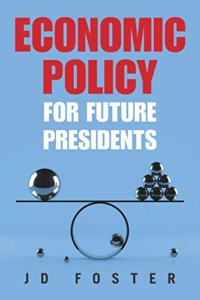Title: Economic Policy for Future Presidents
Author: JD Foster
Publisher: XlibrisUS
ISBN: 978-1-6641-4472-9
Pages: 304
Genre: Economics
Reviewed by: Jason Lulos
Pacific Book Review
Imagine you are the incoming president. Among the many challenges you will face, you’ll have to tackle complexities of the United States Economy. Fear not! In Economic Policy for Future Presidents, author JD Foster advises you (reader/president) on all manner of economic issues: income, taxes, health care, The FED, cost-benefit analysis, and the balance between the relative “free market” and “government regulation.”
This truly insightful book covers a lot and puts the swirling mess of math and economic policies into clear and understandable language. From the taxes you pay, to the national deficit, to just what in the heck the FED actually is, the book gives you a better understanding of economic jargon and a firmer grasp on how and why the economy is interconnected with all aspects of our lives.
JD Foster notes that economics has been unfairly called the “dismal science” because of the gloomy scenario in which our resources and efforts will be unable to keep up with population growth. But Foster sheds light on this so-called gloom with lucid examples
and practical solutions for managing a changing economy. With all solutions, long-term effects must be considered. For instance, regulating rent prices in low-income housing sounds like an ethical move, but might lead a landlord to limit the number of tenants and/or skimp on maintenance, thus defeating the whole idea of that ethical move to make decent housing more affordable and available. This is a prime example of the “law of unintended consequences” – a common refrain in the book. The moral urge to keep rent low seems right and fitting, but the fallout that follows might actually defeat the original purpose.
JD Foster addresses a number of similar scenarios. What would actually happen if the minimum wage was raised significantly? How does/will global warming affect the economy? What does the FED Chair actually do? When something is taxed, who actually – inevitably – pays that tax? Foster indicates that while the economy is complex, it is understandable, even to the layman. However, to quote Donald Rumsfeld, there are some “known unknowns” such as the complexities of the tax code and the payroll tax. Most (but not all) of these “known unknowns” are indeed knowable if you happen to have something like this book as a guide.
Reading this book, I had the sense that the economy is like the weather. With decades of data and growing technology, we are largely successful in making predictions. But with things constantly changing, we must adapt accordingly (from pandemics to global warming to normal cyclical market fluctuations). The analogy with the weather seems apt in this regard too: just as rising sea temperatures can affect global weather patterns, an economic policy (from local rent control to federal regulation to unchecked monopolization), will have consequences. It’s a delicate but manageable balancing act as long as you consider the immediate and long-term butterfly effects.
One of the guiding principles in the book is “if you want less of something, tax it more.” Foster gives compelling reasons for that broad picture – letting the market work out prices, employment, and wages and knowing when to allow the government to intervene in order to solve inequalities and establish social stability and trust from its people. This book is a bit more sophisticated than, say, Economics for Dummies, but it is extraordinarily well written and the conversational tone makes things easily understandable. A lot of enlightening insights and common-sense solutions will appeal to any reader wishing to really understand and appreciate just how the US economy works.


